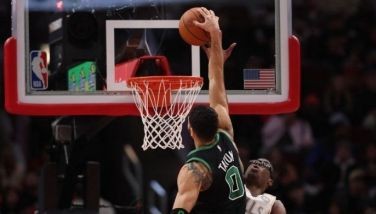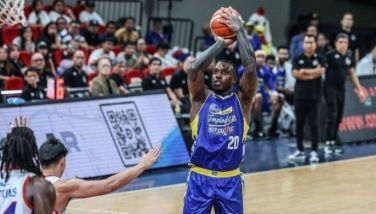Eugene Tejada and ethics in sports
August 1, 2006 | 12:00am
I read a newspaper report that the Purefoods Giants, newly crowned Philippine Basketball Association (PBA) 2006 Philippine Cup champion, is asking for a formal investigation of the incident that resulted in a spinal injury to Fil-Am Eugene Tejada. Tejada suffered a bad fall in an elimination game against Red Bull, the eventual opponent of the Giants in the best-of-seven series that the latter won, 4-2.
The request implies there was no formal investigation of and closure to the incident and the events immediately after Tejada’s bad fall. If there was indeed no formal investigation, then the request of Purefoods is totally valid. If there, however, was a formal investigation of and closure to the incident, the PBA should correct that misimpression of a member that obviously thinks that the Tejada incident is unfinished business.
If it is indeed unfinished business, somebody has to have a clear explanation for Tejada’s inability to practice his profession. Somebody, too, has to have a clear action plan on how to minimize such career-ending incidents and how to serve the ends of justice especially if it can be proven there was intent to harm one’s colleague in the profession.
This incident in the PBA and others elsewhere brings to mind what D. Stanley Eitzen in his paper, "Ethical Dilemmas in Sports," calls the "dark side of sport."
Eitzen says an area of ethical concern has to do with normative violence in sport. Many popular sports encourage player aggression. These sports demand body checking, blocking and tackling. I remember one incident when Lim Eng Beng was playing for De La Salle in the National Collegiate Athletic Association in the early ’70s.
Lim, who continued to be a prolific scorer joined the PBA, was so difficult to defend that one coach of a collegiate team was overheard to have told his player assigned to shadow Lim "when you foul Beng, make sure he feels it." In short, make Lim pay a price for his being such a threat to the opponent.
Such an instruction creates a culture in sports where sometimes players and coaches go way beyond what is needed. As Eitzen points out, players are taught, in the case of American football, to deliver a blow to the opponent and to make the ball carrier "pay the price," as in the case of Lim.
The presumption in overdoing things is that physically punishing the other player will increase the probability of the opponent fumbling, losing his concentration and executing poorly the next time, or having to be replaced by a less talented substitute.
Eitzen points out that the emphasis on intimidating violence has resulted in a much higher injury rate than necessary although it must be pointed out that injuries like the one Tejada suffered are rare in the PBA’s 31-year history.
Sports Illustrated’s John Underwood, whom Eitzen quoted, says, "Brutality is its own fertilizer. From ‘get by with what you can,’ it is a short hop to the deviations that poison sport." But it is not just the acts that border on criminal that are intolerable, it is the permissive atmosphere they spring. The "lesser": evils that are given tacit approval as "techniques" of the game, even within the rules." In Filipino, we call such "techniques of the games even within the rules" alternatively as "utak, abilidad or gulang."
As a result of the cultural context in many sports, players regularly engage in a number of acts that are unethical, considering them as part of their sport. These include acts of intimidation such as physical threats and aggression, taunting and "trash talking," and racial insults (and if I may add, a player’s gender preferences and indiscretions of his spouse); use of drugs to enhance performance.
The whole issue of ethics in sports should however go beyond player behavior and look into coaches, fans and parents too.
Eitzen points out that parents may push their children too far, too fast. Should one-year olds be trying to set records as was the case in 1972 when the national record for the mile run for a one-year-old was set by Steve Parsons of Normal, Illinois, at 24:16.6 (one day short of his second birthday)? Is such a practice appropriate, or is it a form of child abuse? Is it right to send 10-year old children away from home to work out eight hours a day with a gymnastics coach in Houston, a swimming coach in Mission Viejo, California?
Eitzen says, parents may encourage their child to use drugs (diuretics for weight control, drugs to retard puberty). Parents are sometimes too critical of their children’s play, other players, coaches and referees. Some parents are never satisfied. They may have unrealistic expectations for their children, and in doing so, may rob them of their childhood and their self-esteem.
I should know the difference between excessive parental intervention and pure parental concern. I had first hand experience with this when I was commissioner of the Philippine Basketball League and chairman of the Philippine Sports Commission several years ago. Sometimes I found myself spending more time talking to the parents of the athletes than to the athletes themselves.
The most unacceptable consequence of unethical behavior in sports is the danger of behaving in like manner outside of sports. Sports psychologists Brenda Jo Bredemeier and David Shields pointed out in the Eitzen paper that, "often to be good in sports, you have to be bad." You must take unfair advantage and be overly aggressive if you want to win. The implications of this are significant.
The request implies there was no formal investigation of and closure to the incident and the events immediately after Tejada’s bad fall. If there was indeed no formal investigation, then the request of Purefoods is totally valid. If there, however, was a formal investigation of and closure to the incident, the PBA should correct that misimpression of a member that obviously thinks that the Tejada incident is unfinished business.
If it is indeed unfinished business, somebody has to have a clear explanation for Tejada’s inability to practice his profession. Somebody, too, has to have a clear action plan on how to minimize such career-ending incidents and how to serve the ends of justice especially if it can be proven there was intent to harm one’s colleague in the profession.
This incident in the PBA and others elsewhere brings to mind what D. Stanley Eitzen in his paper, "Ethical Dilemmas in Sports," calls the "dark side of sport."
Eitzen says an area of ethical concern has to do with normative violence in sport. Many popular sports encourage player aggression. These sports demand body checking, blocking and tackling. I remember one incident when Lim Eng Beng was playing for De La Salle in the National Collegiate Athletic Association in the early ’70s.
Lim, who continued to be a prolific scorer joined the PBA, was so difficult to defend that one coach of a collegiate team was overheard to have told his player assigned to shadow Lim "when you foul Beng, make sure he feels it." In short, make Lim pay a price for his being such a threat to the opponent.
Such an instruction creates a culture in sports where sometimes players and coaches go way beyond what is needed. As Eitzen points out, players are taught, in the case of American football, to deliver a blow to the opponent and to make the ball carrier "pay the price," as in the case of Lim.
The presumption in overdoing things is that physically punishing the other player will increase the probability of the opponent fumbling, losing his concentration and executing poorly the next time, or having to be replaced by a less talented substitute.
Eitzen points out that the emphasis on intimidating violence has resulted in a much higher injury rate than necessary although it must be pointed out that injuries like the one Tejada suffered are rare in the PBA’s 31-year history.
Sports Illustrated’s John Underwood, whom Eitzen quoted, says, "Brutality is its own fertilizer. From ‘get by with what you can,’ it is a short hop to the deviations that poison sport." But it is not just the acts that border on criminal that are intolerable, it is the permissive atmosphere they spring. The "lesser": evils that are given tacit approval as "techniques" of the game, even within the rules." In Filipino, we call such "techniques of the games even within the rules" alternatively as "utak, abilidad or gulang."
As a result of the cultural context in many sports, players regularly engage in a number of acts that are unethical, considering them as part of their sport. These include acts of intimidation such as physical threats and aggression, taunting and "trash talking," and racial insults (and if I may add, a player’s gender preferences and indiscretions of his spouse); use of drugs to enhance performance.
The whole issue of ethics in sports should however go beyond player behavior and look into coaches, fans and parents too.
Eitzen points out that parents may push their children too far, too fast. Should one-year olds be trying to set records as was the case in 1972 when the national record for the mile run for a one-year-old was set by Steve Parsons of Normal, Illinois, at 24:16.6 (one day short of his second birthday)? Is such a practice appropriate, or is it a form of child abuse? Is it right to send 10-year old children away from home to work out eight hours a day with a gymnastics coach in Houston, a swimming coach in Mission Viejo, California?
Eitzen says, parents may encourage their child to use drugs (diuretics for weight control, drugs to retard puberty). Parents are sometimes too critical of their children’s play, other players, coaches and referees. Some parents are never satisfied. They may have unrealistic expectations for their children, and in doing so, may rob them of their childhood and their self-esteem.
I should know the difference between excessive parental intervention and pure parental concern. I had first hand experience with this when I was commissioner of the Philippine Basketball League and chairman of the Philippine Sports Commission several years ago. Sometimes I found myself spending more time talking to the parents of the athletes than to the athletes themselves.
The most unacceptable consequence of unethical behavior in sports is the danger of behaving in like manner outside of sports. Sports psychologists Brenda Jo Bredemeier and David Shields pointed out in the Eitzen paper that, "often to be good in sports, you have to be bad." You must take unfair advantage and be overly aggressive if you want to win. The implications of this are significant.
BrandSpace Articles
<
>
- Latest
- Trending
Trending
Latest
Trending
Latest
Recommended































